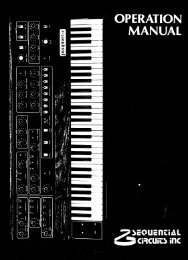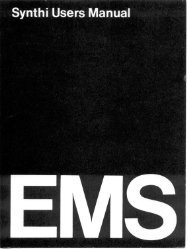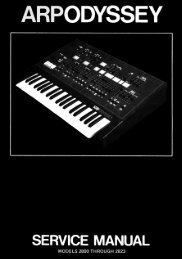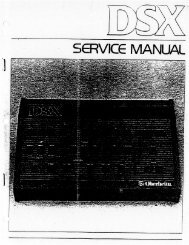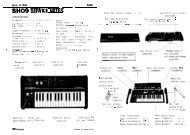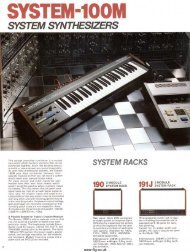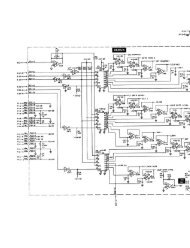ARP2600 - Fundamentals of Music Technology - Cyborgstudio.com
ARP2600 - Fundamentals of Music Technology - Cyborgstudio.com
ARP2600 - Fundamentals of Music Technology - Cyborgstudio.com
Create successful ePaper yourself
Turn your PDF publications into a flip-book with our unique Google optimized e-Paper software.
102 - SECTION THIRTEEN: KEYBOARD CONTROLSThe adverse effect <strong>of</strong> using the interval latch feature is that the same effect can be created by using amonophonic keyboard and tuning the VCOs in intervals. The advantage <strong>of</strong> using the interval latchfeature is that the keyboard can instantly be switched into and out <strong>of</strong> true duophonic operation. Becauseduophonic operation thins the 2600’s sound, interval latching and duophony are best saved for performancesituations rather than studio work, where tape can make up for some <strong>of</strong> these limitations. Usinga tape recorder or a <strong>com</strong>puter, one can record one melody using three VCOs per voice, then go back andadd other melodies to it one at a time, all without sacrificing the ability to use all three VCOs at once.These techniques will be discussed in a later volume <strong>of</strong> this series.PITCH BENDINGOn the 3620, the rather esoteric INTERVAL knob disappeared, to be replacedby a more useful pitch bend knob. This knob is located in the lower left handcorner <strong>of</strong> the keyboard control panel. When it is turned clockwise, the keyboard’sCV rises and will in turn raise the pitch <strong>of</strong> the VCOs. When turned fully clockwise,the VCOs will sound one octave (12 half steps) higher than normal pitch.When the pitch bend knob is turned counterclockwise, the pitch will descend asfar as one full octave below normal pitch.Another wonderful contribution <strong>of</strong> the Moog <strong>Music</strong> <strong>com</strong>pany to the world <strong>of</strong>synthesizers is the pitch bend wheel. This is a large circular knob mountedsideways in the keyboard which can be turned forwards or backwards to bendthe pitch <strong>of</strong> the oscillators up or down. These wheels are spring-loaded, so thatthey will snap back to normal pitch when the performer’s hand leaves them.This is considered to be highly desirable, and almost every pr<strong>of</strong>essional synthesizeron the market today employs this design. The ARP 2600 keyboard, doesnot, however. Instead, they provided a “Dead Area” on the pitch bend knobFigure 13-5: A Moogstylepitch bend wheelwhich was close to the normal pitch area <strong>of</strong> the pitch bend knob. Users had to manually return the knobto normal pitch, which could sometimes be a bit tricky in a darkened room. In time, the ARP designfaded away into oblivion, almost never to be seen in modern synthesizers. In Figure 13-5, the pitchbend wheel on a Casio CZ-101 is shown for <strong>com</strong>parison. It employs the Moog-style pitch bend wheel.The designers also recognized the need to be able to easily transpose the synthesizer’s pitch up anddown without retuning the oscillators. The lever labeled TRANSPOSE allows the keyboard to generatecontrol voltages two octaves lower than normal when it is in the 2 OCTAVES DOWN position, andtwo octaves higher when in the 2 OCTAVES UP position.DEDICATED LFOThe ARP’s designers added another huge advancement to this version <strong>of</strong> the keyboard: a dedicatedLFO. Up to this point in time, when vibrato was needed, one had to sacrifice one <strong>of</strong> the three VCOs,rendering the 2600 a 2-oscillator unit. This really thinned the sound, but it was too sterile withoutvibrato, so it was deemed a necessary evil. The 3620 <strong>of</strong>fers a dedicated LFO. Synthesists can then useall three VCOs in the cabinet for producing sound and use the keyboard’s VCO for producing vibrato.




